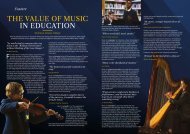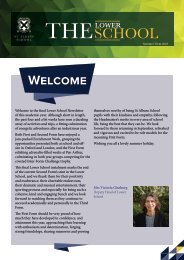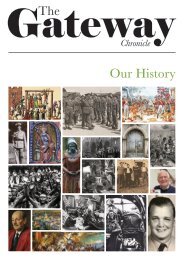You also want an ePaper? Increase the reach of your titles
YUMPU automatically turns print PDFs into web optimized ePapers that Google loves.
5<br />
<strong>The</strong>re was also widespread economic and<br />
social discontent from the events of the Biennio<br />
Rosso (two red years), a period of<br />
unemployment and political instability.<br />
Following World war One, the number of<br />
unemployed had risen to 2 million, while<br />
many factories shut down for lack of government<br />
wartime contracts. This led to<br />
widespread strike action from trade unions,<br />
with 1,881 in 1920 alone and, following<br />
a rejection of their demands, they occupied<br />
factories which brought<br />
the possibility of revolution<br />
even<br />
closer. Fortunately<br />
for the<br />
other parties,<br />
the Socialists<br />
decided not to<br />
call a revolution<br />
due to their voting<br />
base of<br />
trade union<br />
members being<br />
relatively reformist<br />
rather<br />
than revolutionary.<br />
Meanwhile,<br />
the weak coalition<br />
governments<br />
were unable<br />
to supress<br />
any union activity,<br />
only urging<br />
businesses to offer<br />
concessions<br />
and, therefore,<br />
soon lost the<br />
confidence of<br />
the middle class.<br />
Within this period of economic and political<br />
chaos, an opportunity for militaristic,<br />
nationalist movements was presented.<br />
<strong>The</strong>se movements mainly consisted of the<br />
soldiers returning from World War One,<br />
students and ex-syndicalists (a labour<br />
movement that promoted unionism).<br />
<strong>The</strong>se movements expressed themselves<br />
usually in the form of violent agitation<br />
and major clashes with other political<br />
groups, predominantly workers and police<br />
at first but then socialists and communists.<br />
In April 1919, the offices of<br />
‘L’Avanti!’, a socialist daily newspaper,<br />
were burned down by fascist agitators. A<br />
continuing string of violent attacks coming<br />
from socialists, communists and fascists<br />
lasted throughout the inter-war<br />
years. However, of these, attacks by the<br />
fascist ‘Squadristi’ (better known as the<br />
Black Shirts due to the black uniforms<br />
they wore) are the most wellknown.<br />
<strong>The</strong>y were<br />
soon systematically<br />
destroying<br />
any opposition<br />
by using intimidation,<br />
assassination<br />
and<br />
strikebreaking<br />
across Italy, and<br />
even overseas in<br />
the Italian<br />
owned colony<br />
of Libya. Compared<br />
to other<br />
political factions<br />
at the time, the<br />
Squadristi were<br />
well organised,<br />
imitating the<br />
structure of the<br />
Roman military<br />
and, as a result,<br />
they were able<br />
to gain lots of<br />
members - an<br />
estimated<br />
Italian National Fascist<br />
Party logo<br />
200,000 by the<br />
time of the<br />
March on Rome.<br />
<strong>The</strong>y consolidated<br />
power in many regions by installing<br />
Squadristi squad leaders as local bosses.<br />
However, the control of the fascists in<br />
these areas was often welcomed by the<br />
middle class and landowners that wished<br />
to see a return to stability rather than the<br />
numerous strikes and civil unrest they<br />
had seen previously. As a result of this<br />
growing influence, the new ‘National


















